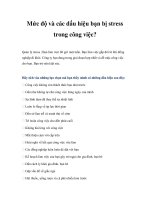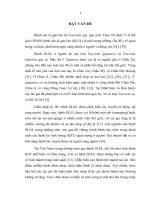CẬP NHẬT CÁC DẤU HIỆU SINH HỌC CHẨN ĐOÁN NHIỄM KHUẨN
Bạn đang xem bản rút gọn của tài liệu. Xem và tải ngay bản đầy đủ của tài liệu tại đây (1.88 MB, 43 trang )
<span class='text_page_counter'>(1)</span><div class='page_container' data-page=1>
<b>Update on Sepsis Biomarkers </b>
William T. McGee, M.D. MHA, FCCM, FCCP
Critical Care Medicine
Associate Professor of Medicine and Surgery
University of Massachusetts
759 Chestnut Street, Springfield, MA 01199
Tel: 413-794-5439 | Fax: 413-794-3987
</div>
<span class='text_page_counter'>(2)</span><div class='page_container' data-page=2>
<b>Community Acquired Pneumonia (CAP)</b>
♦ <sub>5.16-6.11 cases/1000 persons/year</sub>
• <i><b>> 900,000 </b>episodes/yr occur in adults > 65 yrs of age</i>
• <i><b>~20% </b>require hospitalization</i>
♦ <b><sub>> 60,000 </sub></b><sub>deaths in United States in 2005</sub>
• <i>8th</i> <i><sub>most common cause of death</sub></i>
♦ <sub>30-day mortality for hospitalized pts with CAP: </sub><i><b><sub>23%</sub></b></i>
</div>
<span class='text_page_counter'>(3)</span><div class='page_container' data-page=3>
<b>Community Acquired Pneumonia</b>
♦ <sub>Estimated annual direct medical costs of care: </sub><b><sub>$8.5 billion</sub></b>
♦ <sub>Given magnitude of antibiotic (Abx) use associated with CAP, </sub>
ensuring correct diagnosis and appropriate empiric as well as
definitive therapy for optimal course to achieve clinical cure and
reduce risk of ADEs is critical
♦ <sub>Adherence to Abx guidelines improves survival in pts with CAP</sub>
• adherence to Abx treatment guidelines is inconsistent and the
erroneous diagnosis of CAP and misuse of Abx is prevalent
♦ <b><sub>↑’</sub></b><sub>ed LOS, risk of adverse events, and emergence of resistance are </sub>
negative outcomes associated with unnecessary Abx
</div>
<span class='text_page_counter'>(4)</span><div class='page_container' data-page=4>
<b>Interventions to Reduce Abx Exposure</b>
♦ <b><sub>Short-course therapy for CAP</sub></b><sub>: clinically as effective as </sub>
long-course therapy and associated with fewer adverse events
♦ <b><sub>IV to PO conversion</sub></b><sub>: safe at 48-72 hr, even in pts with severe </sub>
CAP, who meet criteria for clinical stability
♦ <b><sub>Biomarkers</sub></b><sub>: use to guide the need for Abx at the start of and </sub>
during therapy leads to reduced Abx exposure without
evidence of pt harm
</div>
<span class='text_page_counter'>(5)</span><div class='page_container' data-page=5></div>
<span class='text_page_counter'>(6)</span><div class='page_container' data-page=6>
<b>6</b>
<b>6</b>
Objectives
♦ Describe pathophysiology of Procalcitonin (PCT)
♦ Describe use of PCT in diagnosis and prognosis of
severe sepsis and septic shock
</div>
<span class='text_page_counter'>(7)</span><div class='page_container' data-page=7>
<b>7</b>
Biomarkers
♦ Characteristic that is objectively measured and
evaluated as an indicator of normal biological process,
pathogenic process, or pharmacologic response to a
therapeutic intervention
♦ Usefulness is evaluated by:
– Capacity to provide timely information beyond what is readily
available from routine physiologic and clinical data (Speed +
Accuracy)
– Sensitivity and specificity
</div>
<span class='text_page_counter'>(8)</span><div class='page_container' data-page=8>
<b>8</b>
Potential Role(s) for Biomarkers
♦ Identify patient with ↑ probability of disease, adverse
outcome, or benefit from intervention
♦ Identify presence or absence of pathologic state or
process
♦ Aid in risk stratification/prognosis
♦ Monitor response to an intervention or treatment
♦ Serve as surrogate endpoint
</div>
<span class='text_page_counter'>(9)</span><div class='page_container' data-page=9>
<b>9</b>
Biomarkers in Sepsis Diagnosis
Sepsis is currently diagnosed using
clinical definitions combined with
</div>
<span class='text_page_counter'>(10)</span><div class='page_container' data-page=10>
Blander & Sander. <b>Beyond pattern recognition: five immune checkpoints for </b>
<b>scaling the microbial threat. </b><i>Nature Reviews Immunology</i><b>12</b>, 215-225 (March 2012)
<b>Pathogen-Associated Molecular Patterns </b>
</div>
<span class='text_page_counter'>(11)</span><div class='page_container' data-page=11>
<b>Procalcitonin (PCT)</b>
♦ <sub>Precursor peptide of mature hormone calcitonin</sub>
♦ <sub>Released in multiple tissues in response to bacterial infections via </sub>
direct stimulation of cytokines
♦ <sub>Cytokines such as interleukin (IL)-6 and tumor necrosis factor (TNF) </sub>
show fast initial spike upon infection
• <i>levels return to normal within a few hrs</i>
• <i>high variability of markers: major challenge for clinical utility</i>
♦ <sub>C-reactive protein (CRP): ↑’es slowly with peak ~ 48-72 hr</sub>
• considered biomarker for inflammation, rather than infection
</div>
<span class='text_page_counter'>(12)</span><div class='page_container' data-page=12>
<b>Procalcitonin</b>
♦ <sub>Increases promptly within 4-6 hrs upon stimulation and ↓’es </sub>
by ~ 50% daily if bacterial infection is controlled by immune
system and supported by effective Abx
</div>
<span class='text_page_counter'>(13)</span><div class='page_container' data-page=13>
Time course PCT successful treatment
<b>13</b>
0
2
4
6
8
10
12
14
16
18
20
1 2 3 4 5 6 7 8
<b>PCT Level</b>
PCT Level
</div>
<span class='text_page_counter'>(14)</span><div class='page_container' data-page=14>
<b>14</b>
Simon L. et al. Clin Infect Dis. 2004; 39:206-217.
Adding PCT results to clinical assessment improves the accuracy of the
early clinical diagnosis of sepsis
• PCT levels accurately differentiate sepsis from noninfectious inflammation*
• PCT has been demonstrated to be the best marker for differentiating patients with sepsis from
those with systemic inflammatory reaction not related to infectious cause
</div>
<span class='text_page_counter'>(15)</span><div class='page_container' data-page=15>
<b>15</b>
Harbarth S et.al. AM J Resp Crit Care Med. 2001; 164:396-402
• When PCT is used as a reference, the sensitivity and specificity of sepsis
diagnosis can be significantly increased compared with conventional clinical
parameters.
<b>Sensitivity: 94%</b>
<b>Specificity: 77%</b>
</div>
<span class='text_page_counter'>(16)</span><div class='page_container' data-page=16>
<b>PCT Regulation on Cellular Level</b>
♦ <sub>Induced in response to microbial toxins and bacterial-induced </sub>
cytokines <i>(IL-1, IL-6, and TNF-α)</i>
• released into bloodstream where it can be measured
♦ <sub>Conversely, production attenuated by cytokines released in </sub>
response to viral infection <i>(interferon (INF)-γ)</i>
</div>
<span class='text_page_counter'>(17)</span><div class='page_container' data-page=17>
<b>17</b>
<b>17</b>
♦ How can we use this cellular signal of infection in the
management of both septic and non
septic patients
♦ Goals
– Provide antibiotic therapy to pts who need it as soon as possible
– Avoid antibiotic prescription to those without infection
</div>
<span class='text_page_counter'>(18)</span><div class='page_container' data-page=18>
<b>Useful Diagnostic Biomarker</b>
♦ <sub>Helps distinguish bacterial infections from other inflammatory </sub>
reactions or viral infections
♦ <sub>Strong correlation between concentration of PCT and extent </sub>
and severity of bacterial infections has been observed in CAP
</div>
<span class='text_page_counter'>(19)</span><div class='page_container' data-page=19>
<b>Utility in Clinical Settings</b>
♦ <sub>102 critically ill pts with systemic infections in ICU found similar PCT </sub>
levels but lower CRP and IL-6 levels in pts treated with systemic
corticosteriods
♦ <sub>Study of 32 healthy volunteers treated with prednisolone 2 hr </sub>
before SIRS induced by injection of <i>E. coli </i>lipopolysaccharide (LPS)
• <b>PCT</b>: no inhibition within study period
• <b>Other biomarkers</b>: significantly inhibited in dose-dependant way
♦ <sub>PCT production does not rely on WBCs</sub>
• <i>Dynamics are expected to be comparable in neutropenic pts</i>
</div>
<span class='text_page_counter'>(20)</span><div class='page_container' data-page=20>
<b>Commercial Detection Assays</b>
♦ <sub>Currently, different assays available for PCT with </sub>
individual performance characteristics
♦ <sub>Reasonably low detection limit especially important </sub>
when antimicrobial stewardship decisions intended
♦ <sub>Kryptor assay: lower level of detection of 0.06 àg/mL</sub>
ã <i>Based on sheep polyclonal anticalcitonin Ab</i>
• <i>Assay used in most intervention studies</i>
♦ VIDAS system from bioMerieux: equally sensitive assay
</div>
<span class='text_page_counter'>(21)</span><div class='page_container' data-page=21>
<b>Diagnosis & Prognosis</b>
♦ <sub>Inherent complexity evaluating diagnostic capability of a novel </sub>
biomarker without presence of diagnostic reference standard
• Optimally, morphological verification such as growth of typical pathogens
or proving histopathology can be obtained to establish “correct” diagnosis
♦ <sub>Causative pathogen cannot be detected in 80% of pts with </sub>
suspected bloodstream infections
♦ <sub>> 70% of pts with radiographically confirmed PNA</sub>
• Causative microbe never identified/isolated
• Usually a syndromic definition of lower respiratory tract infections (LRTIs)
♦ <sub>No “gold standard” to discriminate bacterial from viral etiology</sub>
</div>
<span class='text_page_counter'>(22)</span><div class='page_container' data-page=22>
<b>Diagnosis Dilemma </b>
♦ <sub>Real-life concept focuses primarily on outcomes of pts with out </sub>
without Abx therapy, while discarding alleged gold standards
♦ <sub>Potential dilemma: ambiguity in deciding whether a pt who </sub>
received Abx “just to be sure” and subsequently recovers had a
good outcome because of OR despite Abx therapy
• <i>For example, self-limiting viral LRTIs will also recover despite Abx therapy</i>
♦ <sub>In sepsis and pneumonia, performance of PCT as a tool for Abx </sub>
guidance is best measured in randomized intervention trials
• <i>Assuming there was no outcome-relevant bacterial infection if the pt </i>
<i>recovers without Abx therapy</i>
</div>
<span class='text_page_counter'>(23)</span><div class='page_container' data-page=23>
<b>PCT Cutoff Ranges</b>
♦ <sub>Similar treatment recommendation algorithms based on PCT </sub>
cutoff ranges were all used in all published stewardship studies
♦ <sub>4 classes of Abx treatment recommendations</sub>
• Strongly discouraged
• Discouraged
• Recommended
• Strongly recommended
♦ <sub>Cutoff ranges derived from multilevel likelihood calculations </sub>
obtained in observational studies
• Reflect likelihood of bacterial infection in a distinct entity of infection
</div>
<span class='text_page_counter'>(24)</span><div class='page_container' data-page=24>
<b>PCT Algorithm in LRTIs</b>
♦ <sub>Initiation or continuation of Abx was more or less encouraged </sub>
when levels > 0.5 µg/mL or > 0.25 µg/mL or discouraged when
levels were < 0.1 µg/mL or < 0.25 µg/mL
♦ When Abx therapy was withheld, clinical re-evaluation and a
2nd <sub>measurement of PCT performed after 6-24 hr if clinical </sub>
condition did not improve spontaneously
♦ <sub>Specific “overruling” criteria were defined, were the algorithm </sub>
could be bypassed and Abx initiated at physician’s discretion
• <i>Namely in life-threatening disease or immediate need for ICU </i>
<i>admission because of respiratory or hemodynamic instability</i>
</div>
<span class='text_page_counter'>(25)</span><div class='page_container' data-page=25></div>
<span class='text_page_counter'>(26)</span><div class='page_container' data-page=26>
<b>ProRESP Trial</b>
♦ <sub>1</sub>st <sub>intervention study testing hypothesis that PCT can be used </sub>
to guide initiation of Abx in pts with LRTI in the ED
♦ <sub>243 pts with LRTI</sub>
• Outcomes of both groups were not different
• PCT-guided group: less Abx Rx (44 vs 83%)
• Strongest effect seen in pts with acute bronchitis and exacerbated COPD
</div>
<span class='text_page_counter'>(27)</span><div class='page_container' data-page=27>
<b>ProCAP and ProCOLD</b>
♦ <sub>2 subsequent prospective RCTs evaluating effect of PCT </sub>
guidance for Abx discontinuation in CAP and to assess pt safety
over 6-mo follow-up period in pts with exacerbated COPD
♦ <b><sub>ProCAP</sub></b><sub>: 302 pts with mostly severe CAP (>60% with PSI IV & V)</sub>
• PCT-guided therapy: Abx courses 65% shorter than in standard regimens
♦ <b><sub>ProCOLD</sub></b><sub>: 208 pts with exacerbated moderate-to-severe COPD</sub>
• PCT-guided therapy: Abx Rx’s reduced from 72% to 40% initially
• Lasting effect in follow-up period of 6-mo
• <i>Safety and Outcomes</i>: Re-exacerbation rates and FEV-1 improvement over
6-mo were same in intervention and control groups
</div>
<span class='text_page_counter'>(28)</span><div class='page_container' data-page=28>
♦ <sub>Large multicenter trial </sub>
– 6 hospitals in Switzerland with > 1300 pts
– Predefined web-based guidelines had to be followed for every pt in
control group in order to ensure optimal adherence to guidelines
♦ Abx exposure vs. treatment according to defined guidelines:
• ↓ by 32.4% in CAP; 50.4% in exacerbated COPD; 65% in acute bronchitis
♦ <sub>Overall reduction in Abx use translated into reduction in </sub>
associated side effects of ~ 30% in pts treated according to PCT
</div>
<span class='text_page_counter'>(29)</span><div class='page_container' data-page=29>
Additional
<i>a priori </i>
Results
• (B) Predictive value of baseline
PCT to determine + culture
(blood, urine, respiratory)
– Positive vs. Negative culture
• 9.8ng/mL [1.7-41.3] vs.
3.3ng/mL[0.6-15.8] p<0.001
• 61% of cultures were positive
• (C) Predictive value of baseline
PCT to determine sepsis
severity
– Septic shock vs. Sepsis
• 13.6ng/mL [2.7-55.2] vs. 3.6[0.5-15.6],
p<0.001
</div>
<span class='text_page_counter'>(30)</span><div class='page_container' data-page=30>
Additional
<i>a priori </i>
Results
• Baseline PCT was similar in survivors and non-survivors however there was a
significantly faster decline overtime in the serial PCT levels in survivors
• Baseline cut off of ≤ 3ng/mL excluded positive blood culture with a sensitivity of
90% (95% CI, 82-89) and a NPV of 96% (95% CI, 93-99)
• Baseline cut off of ≤ 0.1ng/mL excluded positive culture in the first 72h with a
sensitivity of 100% and NPV of 100%
</div>
<span class='text_page_counter'>(31)</span><div class='page_container' data-page=31>
♦ <sub>In 2012, all these data were pooled in large meta-analysis </sub>
using individual data of <b>4221</b> patients in 14 trials
♦ <sub>Markedly reduced Abx exposure overall</sub>
• <b>8d vs. 4d </b>and adjusted difference of <b>-3.47d </b><i>(95% CI: -3.78 to -3.17)</i>
• No increase in mortality or treatment failure
</div>
<span class='text_page_counter'>(32)</span><div class='page_container' data-page=32>
<b>Meta-analysis Results</b>
♦ <sub>Primary care setting: mainly due to ↓ Rx rates</sub> <b><sub>(23% vs. 63%)</sub></b>
• Pts with upper ARI: <b>15% vs. 48%, </b>adjusted OR: 0.14 <i>[95% CI: 0.09-0.22]</i>
• Pts with bronchitis: <b>24% vs. 66%, </b>adjusted OR: 0.15 <i>[95% CI: 0.10-0.23]</i>
♦ <sub>In ED and ICU pts, shorter courses of Abx treatment were found</sub>
• ED: <b>7d vs. 10d</b>, difference - 3.7d <i>[95% CI: - 4.09 to - 3.31]</i>
• ICU: <b>8d vs. 12d</b>, difference - 3.17d <i>[95% CI: - 4.28 to – 2.06]</i>
♦ <sub>In CAP, Abx exposure markedly shorter: </sub>
• Difference <b>– 3.34d </b><i>[95% CI: - 3.79 to – 2.88]</i>
• Associated with lower risk of treatment failure (<b>19.1% vs. 21.9% </b>in
standard treatment arm) <i>adjusted OR: 0.82; 95% CI: 0.71 – 0.97</i>
</div>
<span class='text_page_counter'>(33)</span><div class='page_container' data-page=33>
<b>Results: All Subjects</b>
</div>
<span class='text_page_counter'>(34)</span><div class='page_container' data-page=34>
<b>Results: Exacerbated COPD</b>
</div>
<span class='text_page_counter'>(35)</span><div class='page_container' data-page=35>
<b>Assay Characteristics</b>
♦ <sub>Timely decision making: great importance in bacterial </sub>
infections
♦ <sub>2 retrospective studies: improved mortality in pts with </sub>
CAP who received 1st <sub>dose of Abx within 4-8 hr</sub>
♦ <sub>In all intervention trials, PCT measured using rapid </sub>
sensitive assay with assay time of 20 min
• <i>Results readily available around the clock and within 1 hr</i>
</div>
<span class='text_page_counter'>(36)</span><div class='page_container' data-page=36>
<b>Implications for Antimicrobial Stewardship</b>
♦ <sub>Key in real-life setting: strong adherence rate to PCT algorithm </sub>
to have same effect of reduced Abx exposure in clinical
practice as found in controlled studies
♦ <sub>Unlike controlled studies were adherence is monitored</sub>
• <i>Results frequently inadequately implemented in daily practice</i>
♦ <i><sub>Aujesky et al</sub></i><sub>: </sub><b><sub>37.4% </sub></b><sub>of pts with low PSI scores hospitalized</sub>
• <i>Mainly due to comorbidities</i>
• <i>Reflects difficulty of implementing guidelines into clinical practice</i>
</div>
<span class='text_page_counter'>(37)</span><div class='page_container' data-page=37>
<b>PCT Registry Study</b>
♦ <sub>Investigated feasibility/effectiveness of PCT-guided </sub>
stewardship in real-life setting of medical clinic in Switzerland
♦ <sub>302 pts with LRTIs of all severities (64% PSI IV and V)</sub>
♦ <b><sub>73% </sub></b><sub>of pts treated according to PCT-guided algorithm</sub>
• Abx therapy applied in <b>71% </b>of pts
• Median duration of treatment: <b>6d</b>
• Significant improvement when compared to control group from
previous trial at same hospital (ProHOSP)
</div>
<span class='text_page_counter'>(38)</span><div class='page_container' data-page=38>
<b>ProREAL</b>
♦ <sub>Study of 1759 pts in US, France, Switzerland</sub>
♦ <sub>Overall adherence to PCT-guided stewardship in 68% pts</sub>
• Adherence: acute bronchitis (81%); exacerbated COPD (70%); CAP (64%)
• Outpatient setting (86%) vs. Inpatient setting (66%)
♦ <sub>After multivariate adjustment, significantly shorter Abx </sub>
exposure demonstrated with PCT algorithm
• <b>5.9d vs. 7.4d</b>; difference – 1.51d <i>[95% CI: - 2.04 to – 0.98]</i>
♦ <i><sub>No increase in risk of combined adverse outcome end point within </sub></i>
<i>30d of follow-up in respect to withholding Abx and early cessation</i>
</div>
<span class='text_page_counter'>(39)</span><div class='page_container' data-page=39>
<b>Associations of Procalcitonin Testing with </b>
<b>Clinical Outcomes and Antibiotic Use </b>
<b>Procalcitonin Group (n =</b>
<b>3336)</b>
<b>Control Group (n = 3372)</b> <b>Between-Group Difference (95%</b>
<b>CI)</b> <b><sub>Adjusted OR (95% CI)</sub><sub>a</sub></b>
<b>P</b>
<b>Value</b>
<b>Clinical Outcomes</b>
<b>30-d mortality, No. (%)</b> 286 (8.6) 336 (10.0) 0.83 (0.70 to 0.99) <b>.04</b>
<b>Treatment failure, No. (%)b</b> 768 (23.0) 841 (24.9) 0.90 (0.80 to 1.01) <b>.07</b>
<b>Length of ICU stay, median (IQR), d</b> 8.0 (4.0 to 17.0) 8.0 (4.0 to 17.0) 0.39 (−0.81 to 1.58) <b>.52</b>
<b>Length of hospital stay, median (IQR), d</b> 8.0 (2.0 to 17.0) 8.0 (2.0 to 17.0) −0.19 (−0.96 to 0.58) <b>.63</b>
<b>Antibiotic-related adverse effects, No./total (%)</b> 247/1513 (16.3) 336/1521 (22.1) 0.68 (0.57 to 0.82) <b>.001</b>
<b>Antibiotic Exposure</b>
<b>Rates for initiation of antibiotics, No./total (%)</b> 2351/3288 (71.5) 2894/3353 (86.3) 0.27 (0.24 to 0.32) <b>.001</b>
<b>Duration of antibiotics, median (IQR), d</b> 6.0 (4.0 to 10.0) 8.0 (6.0 to 12.0) −1.83 (−2.15 to −1.50) <b>.001</b>
</div>
<span class='text_page_counter'>(40)</span><div class='page_container' data-page=40>
<b>Procalcitonin Conclusions</b>
♦ <sub>Evidence supports PCT as accurate surrogate biomarker for </sub>
likelihood and severity of bacterial infections
♦ <sub>In CAP and other respiratory infections, PCT-guided algorithms </sub>
resulted in ↓’ed Abx exposure
• Maintaining similar or better level of safety compared with standard care
♦ <sub>Reductions in Abx use translate to decreased:</sub>
• Costs, risk of side effects, and bacterial resistance
</div>
<span class='text_page_counter'>(41)</span><div class='page_container' data-page=41>
<b>Conclusions</b>
♦ <b>Short-course therapy for CAP</b>: clinically as effective as
long-course therapy and associated with fewer adverse
events
♦ <b>IV to PO conversion</b>: safe at 48-72 hr, even in pts with
severe CAP, who meet criteria for clinical stability
♦ <b>Procalcitonin</b>: use to guide the need for Abx at the start
of therapy leads to reduced Abx exposure without
</div>
<span class='text_page_counter'>(42)</span><div class='page_container' data-page=42></div>
<span class='text_page_counter'>(43)</span><div class='page_container' data-page=43></div>
<!--links-->
Cập nhật các nghiệp vụ phát sinh trong doanh nghiệp
- 20
- 804
- 2








